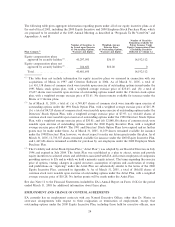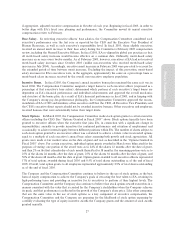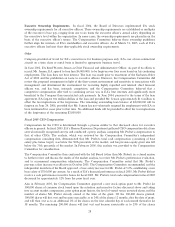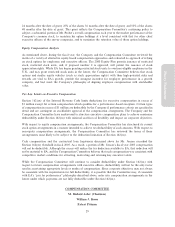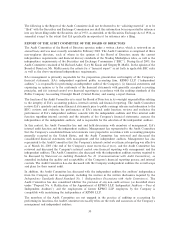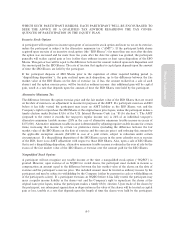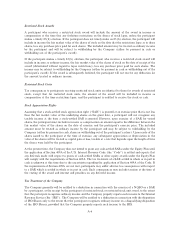Electronic Arts 2005 Annual Report Download - page 41
Download and view the complete annual report
Please find page 41 of the 2005 Electronic Arts annual report below. You can navigate through the pages in the report by either clicking on the pages listed below, or by using the keyword search tool below to find specific information within the annual report.
24 months after the date of grant, 25% of the shares 36 months after the date of grant, and 50% of the shares
48 months after the date of grant. This grant reÖects the Compensation Committee's continuing policy to
subject a substantial portion of Mr. Probst's overall compensation each year to the market performance of the
Company's common stock, to maintain his option holdings at a level consistent with that for other chief
executive oÇcers of the survey companies, and to maximize the retention value of those option holdings.
Equity Compensation Analysis
As mentioned above, during the Ñscal year, the Company and the Compensation Committee reviewed the
merits of a variety of alternative equity-based compensation approaches and evaluated its approach of relying
on stock options for employees and executive oÇcers. The 2000 Equity Plan permits issuance of restricted
stock, restricted stock units, and, if proposal number 2 is approved, will permit the issuance of stock
appreciation rights. While EA has begun granting restricted stock units to overtime-eligible employees in the
U.S., and may grant restricted stock units in the future, the Compensation Committee believes that stock
options and similar equity vehicles (such as stock appreciation rights) with their high-potential risks and
rewards are vital to EA's growth, provide the strongest incentive for employee performance in a growth
company, and best meet the Company's philosophy of aligning employee compensation with stockholder
value.
Tax Law Limits on Executive Compensation
Section 162(m) of the Internal Revenue Code limits deductions for executive compensation in excess of
$1 million except for certain compensation which qualiÑes for a performance-based exception. Certain types
Proxy Statement
of compensation in excess of $1 million are deductible by the Company if performance criteria are speciÑed in
detail and are contingent on stockholder approval of the compensation arrangement. The Company and the
Compensation Committee have endeavored to structure executive compensation plans to achieve maximum
deductibility under Section 162(m) with minimal sacriÑces of Öexibility and impact on corporate objectives.
With respect to equity compensation arrangements, the Compensation Committee has structured its current
stock option arrangements in a manner intended to achieve tax deductibility of such amounts. With respect to
non-equity compensation arrangements, the Compensation Committee has reviewed the terms of those
arrangements most likely to be subject to the deduction limitation of Section 162(m).
Cash compensation and the contractual loan forgiveness discussed above for Mr. Jenson exceeded the
Section 162(m) threshold in Ñscal 2005. As a result, a portion of Mr. Jenson's Ñscal year 2005 compensation
will not be deductible. Although the excess will reduce the tax deduction available to EA, that reduction will
not be material to EA, and the Compensation Committee believes that such compensation was consistent with
competitive market conditions for attracting, motivating and retaining key executive talent.
While the Compensation Committee will continue to consider deductibility under Section 162(m) with
respect to future compensation arrangements with executive oÇcers, deductibility will not be the only factor
used in ascertaining appropriate levels or modes of compensation. Since corporate objectives may not always
be consistent with the requirements for full deductibility, it is possible that the Committee may, if consistent
with EA's ""pay for performance'' philosophy described above, enter into compensation arrangements in the
future under which payments are not fully deductible under Section 162(m).
COMPENSATION COMMITTEE
M. Richard Asher (Chairman)
William J. Byron
Robert Pittman
29







